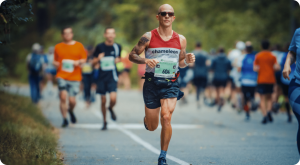Triathletes push their physical and mental limits by swimming, biking, and running to finish a challenging course as quickly as possible.
Triathlon races are not merely about conquering the course but also about understanding how to recover effectively and holistically to maintain long-term health and continue excelling in the sport.
Let’s explore the importance of proper recovery after half Ironman, ironman, and other triathlon races.
Body Recovery Period After Triathlon
Once the exhilarating but grueling triathlon race comes to an end, athletes find themselves in the immediate triathlon recovery phase, a critical period that sets the foundation for their overall recuperation.
This phase involves several key components, one of which is the establishment of a designated recovery zone and access to medical assistance when needed.
Recovery Zone
A well-organized recovery zone is a pivotal component of any triathlon event.
In this area, athletes can regain composure, rehydrate, and refuel with nutritious snacks or beverages.
Typically, the recovery zone is equipped with amenities such as shade, seating, and medical personnel who can address minor injuries and dehydration.
It is recommended that athletes use this area to start their recovery process in the best possible way.
The recovery zone not only offers physical relief but also serves as a psychological anchor after the intense race.
In the recovery zone, athletes can also engage in light stretching and mobility exercises to prevent muscle stiffness and promote blood circulation.
This helps reduce the immediate post-race discomfort and sets the stage for further recovery.

Medical Assistance
Despite rigorous preparation, triathlon races can sometimes lead to minor injuries or health issues.
Athletes may suffer from dehydration, muscle strains, cramps, or other health problems.
To address these potential issues promptly, medical assistance is readily available at triathlon events.
Qualified medical professionals, including paramedics and physicians, are on hand to assess and treat athletes if necessary.
Athletes are encouraged to communicate openly with medical staff about any discomfort or injury, as early intervention can prevent minor issues from developing into more severe problems.
It’s crucial to recognize that in the immediate Ironman recovery phase, prompt medical attention can be the key to ensuring athletes recover optimally and prevent any long-term health complications.
Short-Term Recovery Phase
The short-term recovery phase is a critical period following the immediate post-Ironman recovery.
During this stage, triathletes must pay careful attention to their nutritional needs and prioritize rest to initiate the healing process.
Here we will discuss the two most important facets of short-term recovery: the need for proper nutrition and the importance of restorative practices and sleep.

Nutritional Requirements
– In the immediate aftermath of a triathlon, the body’s energy stores are significantly depleted.
Replenishing these stores is paramount for the triathlon recovery process.
Proper nutrition is crucial to refuel, repair, and rebuild the body.
– During this stage, carbohydrates are crucial because they support the glycogen stores of the liver and muscles.
Fast-digesting carbohydrates like fruits and energy gels can provide an immediate source of energy.
– Protein is also essential for repairing muscle damage that occurs during the race.
Including lean protein sources such as poultry, fish, or plant-based options is recommended.
– Hydration is another key aspect of nutrition.
Electrolyte-rich fluids can help restore the body’s electrolyte balance after sweating profusely during the race.
If you want to learn more about triathlon nutrition during race, check out this article.
Sleep and Restorative Practices
– Sleep is often referred to as the body’s natural healer.
Adequate rest is fundamental in the short-term recovery phase.
Athletes should prioritize a full night’s sleep, aiming for 7-9 hours, to allow the body to repair and regenerate.
– In addition to regular sleep, incorporating restorative practices such as naps or meditation can be highly beneficial.
Short power naps of 20-30 minutes can help enhance alertness and mood, while meditation or relaxation exercises aid in reducing stress and promoting mental recovery.
– Contrast baths, where athletes alternate between hot and cold water immersion, can help reduce muscle inflammation and improve circulation.
Foam rolling and massage are other techniques that can alleviate muscle soreness and tightness.
It is important to recognize that short-term recovery includes not only physical healing but mental healing as well.
Triathletes should engage in leisure activities such as reading, socializing with loved ones, or pursuing a hobby.
The transition period between the immediate post-race recovery and the long-term recovery pathway is known as the short-term recovery phase.
Proper nutrition, adequate sleep, and restorative practices enable the body to heal and prepare for the gradual return to training and competition.
By paying close attention to these aspects, triathletes can ensure a smoother transition into the subsequent phases of Ironman recovery.
Long-Term Recovery Phase
The long-term recovery phase marks a pivotal stage in a triathlete’s journey after a race.
Athletes must carefully consider when and how to return to training during this phase.
Here, we will explore the two key components of the long-term recovery phase: listening to your body and embracing structured training for half-ironman plans.

Listen to Your Body
– It’s important to continue to pay attention to your body’s signals and cues after a triathlon race.
The stress and strain of a race can cause several physical and psychological symptoms, including emotional fatigue, muscle soreness, and exhaustion.
– Pay close attention to any lingering pain or discomfort.
It’s important to honor your body’s request for more average Ironman time to heal when it sends that message.
Burnout, overuse injuries, and overtraining can result from pushing too hard too soon.
– Triathletes should learn to be self-aware and assess their well-being, training enthusiasm, and energy levels.
Understanding your body’s needs is a critical skill in the long-term healing process.
Structured Training Plans
– Having a well-thought-out plan for when to return to exercise is just as important as paying attention to your body.
A gradual return to exercise is essential for long-term healing.
– Consider consulting with a coach or sports scientist who can design a personalized training plan that factors in your race performance, current fitness level, and long-term goals. If you haven’t found a coach yet, here are some tips on how to choose the best triathlon coach.
– Structured training plans typically follow a Norwegian periodization model, which involves phases of base training, intensity, and tapering before the next race. Check out how to taper a marathon.
This approach allows the body to adapt progressively, reducing the risk of injuries and optimizing performance.
– Cross-training can also be a valuable component of structured plans.
Exercises outside of the three triathlon disciplines, such as yoga or strength training, can help correct muscular imbalances and spice up your routine.
It’s worth noting that the long-term Ironman recovery phase is not solely about returning to training but also about fostering a mindset of patience and resilience.
Triathletes may experience failures or periods of inactivity, but it’s these times that foster both individual growth and sustained success in the sport.

Holistic Recovery Approach
A holistic approach to recovery after a triathlon race encompasses not only the physical aspects but also the crucial realm of mental recuperation.
The fifth section of this article explores the importance of balancing mental and physical recovery for the overall health of triathletes.
Physical Recovery
– Physical recovery is often the first aspect that comes to mind in the aftermath of a challenging triathlon.
It involves strategies such as nutrition, hydration, rest, and structured training plans, as discussed in earlier sections.
– Nutrient-rich foods, sufficient sleep, and well-structured workouts contribute to the restoration of energy stores, repair of muscle tissue, and the prevention of physical injuries and overtraining.
– Physical post ironman recovery ensures that the body is ready to tackle future training sessions and competitions, promoting both short-term and long-term athletic success.

Mental Recovery
– The mental aspect of recovery is equally, if not more, vital.
Triathletes often undergo intense emotional experiences during a race, which can lead to mental exhaustion, anxiety, or burnout if not managed effectively.
– Techniques such as mindfulness, relaxation, and meditation play a significant role in mental recovery.
They help triathletes regain focus, manage stress, and build mental resilience.
– Reflecting on the race, setting new goals, and acknowledging personal achievements are essential for maintaining athlete motivation and mental well-being.
Triathletes should cultivate a positive mindset to sustain their passion for the sport.
Balancing Physical and Mental Recovery
– The art of achieving a holistic recovery approach lies in the harmonious interplay between physical and mental recovery strategies.
The two are closely related, and the health of one affects the other.
– Physical recovery supports mental recovery by providing a sound foundation for mental health.
Focus, stress reduction, and optimism are easier for the mind to maintain when the body is well-nourished and rested.
– Mental recovery, on the other hand, complements physical recovery by reducing emotional fatigue and enhancing motivation.
A positive mental state can lead to better adherence to structured training for half-ironman plans and a greater sense of fulfillment in the sport.
The holistic post Ironman recovery approach encourages triathletes to recognize the dynamic interaction between the physical and mental aspects of recuperation.
Balancing these components is a skill that can significantly improve overall performance, promote sustainable athletic careers, and enhance the quality of life.
Triathletes who adopt this comprehensive strategy are better prepared to meet the demands of their sport with resilience, vigor, and a sense of fulfillment.
Real-Life Examples of Athletes’ Recovery Journeys
Case studies provide invaluable insights into the practical application of recovery strategies and the challenges that athletes face in their post-race recuperation.
In this segment, we will examine real-life examples of triathletes’ recovery journeys, highlighting the insights and lessons that can help all athletes.
Case Study 1: Sarah’s Comeback Journey
– Sarah, a dedicated triathlete, suffered a knee injury during a race that left her sidelined for several months.
Her recovery journey began with immediate medical attention, including physical therapy.
– Overcoming the mental and emotional hurdles of injury, Sarah engaged in a structured rehabilitation plan, combining physical therapy with psychological support.
– The key takeaway: Sarah’s story illustrates the importance of seeking professional guidance when dealing with injuries and the significance of mental resilience in the recovery process.
Case Study 2: Tom’s Seasonal Transition
– Tom, an experienced triathlete, recognized the importance of a structured long-term recovery phase between racing seasons.
– During the off-season, Tom balanced physical recovery through light cross-training and a gradual return to training with mental recovery by exploring new hobbies and spending quality average Ironman time with his family.
– The key takeaway: Tom’s case demonstrates the value of setting clear boundaries between racing seasons and the benefits of nurturing both physical and mental well-being during the break.
By drawing inspiration from these real-life examples, triathletes can gain valuable insights into how to navigate their recovery journeys successfully.
Although every triathlete’s recovery journey is different, athletes at all levels of the sport can benefit from the universal concepts of listening to your body, accepting structured plans, and finding a balance between physical and mental recovery.
Conclusion: The Importance of Recovery Time for Triathletes
In summary, the process of recovering from an intense triathlon race is complex and includes phases of immediate, short-term, and long-term recovery.
Triathletes must take a holistic approach to recovery and recognize the importance of these phases to their overall health and performance.






